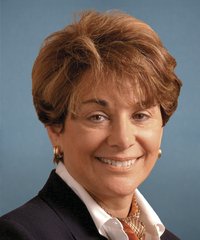
Like the Silicon Valley region she represents, Congresswoman Anna G. Eshoo exemplifies innovation. She’s creative, boundary breaking and productive. She is a problem solver and a consensus builder. In Rep. Eshoo’s two decades in Congress, she has defended consumers, promoted American competitiveness and innovation, fought for access to health care for families and children, protected the environment, and encouraged development of clean energy technology.
Rep. Eshoo’s work consistently earns the highest approval from a wide range of organizations, including the League of Conservation Voters, the Humane Society, the American Association of University Women, Iraq and Afghanistan Veterans, the Biotechnology Industry Organization, the American College of Emergency Physicians, and the Science Coalition. The San Jose Mercury News named her one of the ten most powerful women in Silicon Valley “because she sits on committees that oversee the Internet and biotech—areas vital to the valley’s interests.”
California’s 18th Congressional District has played an important role in our nation’s history. Rep. Eshoo is committed to preserving local history and supporting our communities in doing so. As part of this commitment, she has been the leading advocate for the preservation of Hangar One at Moffett Field, a landmark integral to the South Bay’s history and community identity.
Hangar One, on the site of what is now called Moffett Field, is located next to the cities of Sunnyvale and Mountain View. The Hangar was constructed by the Navy in 1932, providing hundreds of jobs in the midst of the Great Depression. It was built to house the USS Macon, the largest airship in the world at that time. Covering eight acres (enough to house 10 football fields), with walls curving to a height of 198 feet, the Hangar remains one of the largest freestanding structures in the country. In 1939, Moffett Field and Hangar One became home to the advanced aerospace laboratory of the National Advisory Committee for Aeronautics (NACA), which later became NASA. During World War II, Hangar One held aircraft and trained personnel essential to the war effort.
Today, Hangar One is a historic landmark that helps define the landscape of the South Bay region and Silicon Valley. NASA sought to develop Hangar One into an interactive space and science center. However, polychlorinated biphenyls (PCBs), toxic to humans and the environment were found in the Hangar’s siding from previous Naval operations, and Rep. Eshoo has consistently advocated that Hangar One be cleaned up and returned to the community.
Rep. Eshoo continues to advocate for Hangar One in Congress, a testament to Silicon Valley’s historical contributions to America’s twentieth-century progress, and a source of pride and potential for local communities. She has been joined by business organizations, community groups and historic preservation associations in advocating for Hangar’s preservation